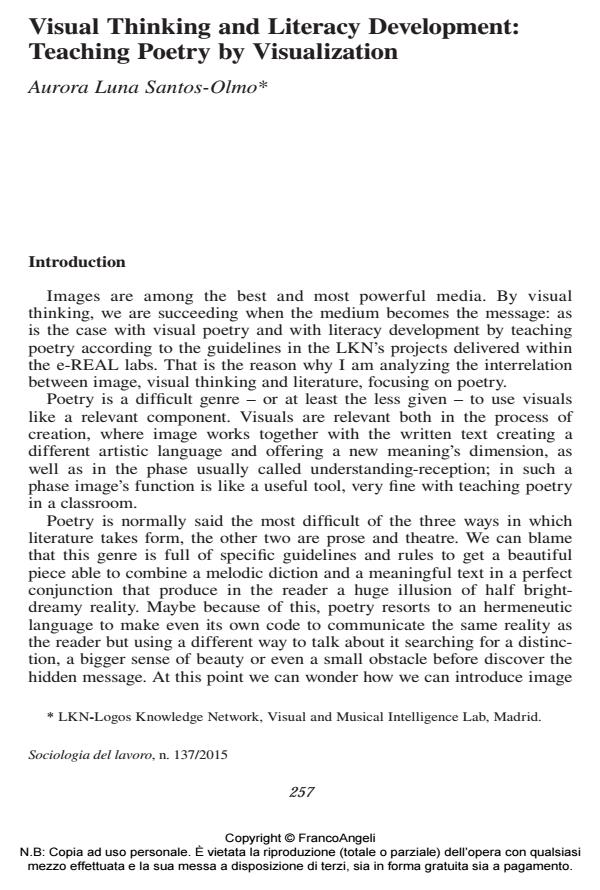Visual Thinking and Literacy Development: Teaching Poetry by Visualization
Journal title SOCIOLOGIA DEL LAVORO
Author/s Aurora Luna Santos-Olmo
Publishing Year 2015 Issue 2015/137
Language English Pages 13 P. 257-269 File size 175 KB
DOI 10.3280/SL2015-137016
DOI is like a bar code for intellectual property: to have more infomation
click here
Below, you can see the article first page
If you want to buy this article in PDF format, you can do it, following the instructions to buy download credits

FrancoAngeli is member of Publishers International Linking Association, Inc (PILA), a not-for-profit association which run the CrossRef service enabling links to and from online scholarly content.
The United Nations Educational, Scientific and Cultural Organization (UNESCO) defines literacy as the ability to identify, understand, interpret, create, communicate and compute, using printed and written materials associated with varying contexts. Literacy involves a continuum of learning in enabling individuals to achieve their goals, to develop their knowledge and potential, and to participate fully in their community and wider society. Images are among the best and most powerful media. By visual thinking, we are succeeding when the medium becomes the message: that is the case with visual poetry and with literacy development by teaching poetry accordingly with the guidelines from the LKN’s projects delivered within the e-REAL labs. That is the reason why in the paper are analyzed the interrelation between image and literature, focusing on poetry. Poetry is the more difficult genre - or at least the less given - to use visuals like a relevant component. Visuals are relevant both in the process of creation, where image works together with the written text creating a different artistic language and opening a new hermeneutic dimension, as well as in the understanding-reception, where image’s function is like a useful tool to teach poetry in a classroom.
Keywords: Visual thinking, literacy development, poetry, success stories
- Abdul Rahman A., Coles K., Lein J., Wynne M. (2013). Reading Freedom and Flow: A New Approach to Visualizing Poetry. Digital Humanities. Acrostic Poetry and PicCollage: --www.liquidliteracy.com.
- Ayiter E. (2008). “Integrative art education in a metaverse: ground”, Technoetic Arts: A Journal of Speculative Research, vol. 6, n. 1, Intellect Books UK.
- Bauman Z. (2003). Liquid Life. Cambridge: Cambridge Polity Press. Bennet J.M., ed. (2008). intro.: Visual Poetry in the Avant Writing Collection. Ohio State University Libraries.
- Bohn W. (2001). Modern Visual Poetry. Associated University Presses.
- Bohn W. (2010). Reading Visual Poetry. Farleigh Dickinson University Press.
- Castells M., Cardoso G., eds. (2005). The Networked Society: From Knowledge to Policy. Washington DC: Johns Hopkins Center for Transatlantic Relations.
- Chatuverdi M., Gannod G., Mandell L., Armstrong H., Hodgson E. (2012). Myopia: A Visualization Tool in Support of Close Reading. University of Miami, Digital Humanities.
- Christin A.-M. “Plastic Arts and Literature”, Comparative Literature: Sharing Knowledges for Preserving Cultural Diversity, vol. 1. Encyclopedia of Life Support Systems.
- Dedora B., ed. (2011). Experimental Writing: a short talk with a lot of Readings. Visual Writing, UbuWeb.
- Digital Reading Network: --www.digitalreadingnetwork.com. Digital poetry: Vision, text+cognition: poetrybeyondtext.org.
- Di Rosario G. (2009). Digital Poetry: a Naissance of a New Genre? Universitat Oberta de Catalunya.
- Edeline F. (2012). The Use of Colour in Visual Poetry, Óbuda University e-Bulletin, vol. 3, n. 1.
- EPFL introductory course on Digital Humanites: --http://dh101.ch.
- Higgins D. (1987). Pattern Poetry: Guide to an Unknown Literature. State University of New York Press.
- Houston N.M., Audenaert N. (2013). Reading the Visual Page of Victorian Poetry, Digital Humanities. --http://clockblock.deviantart.com. --http://quest.arc.nasa.gov/aero/wright/teachers/wfomanual/langarts/poem.html
- http://clockblock.deviantart.com.
- International Society for Technology in Education: --www.iste.org, Kentucky Association of School Administrators: www.kasa.org,
- Knowles K., Schaffner A.K., Weger U., Roberts A.M. Reading Space in Visual Poetry: New Cognitive Perspective. Nottingham Trent University.
- Mathai S., Visual Thinking in a Classroom: Insights from Research Literature. Mumbai, India: Homi Bhabha Centre for Science Education.
- McClure D.W. (2013). Exquisite Haiku: Experiments with Real-Time, Collaborative Poetry Composition.
- Meneses L., Furuta R., Mandell L. (2013). Ambiances: A Framework to Write and Visualize Poetry. Digital Humanities.
- Millan F., Pensamiento visual, comunicación de masa y experimentación-Una poesía global. Merzmail.net --www.educationworld.com.www.fluxus.org.
- www.educationworld.com.www.fluxus.org.
- Zwerling Sugano M. (1992). The Poetics of the Occasion: Mallarmé and the Poetry of Circumstance, Stanford University Press.
Aurora Luna Santos-Olmo, Visual Thinking and Literacy Development: Teaching Poetry by Visualization in "SOCIOLOGIA DEL LAVORO " 137/2015, pp 257-269, DOI: 10.3280/SL2015-137016